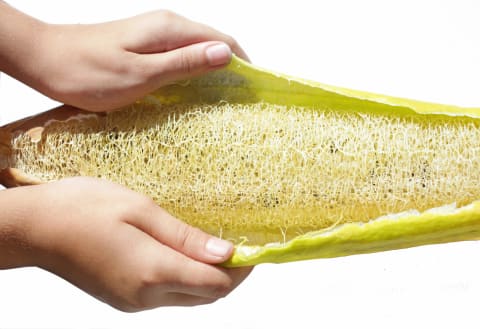All luffa is native to hot, tropical locales, so this is a sun-loving plant that will grow best in warmer climates. And grow it will. When a luffa vine is happy in its environment, it can reach 30-plus feet high and produce 50 large gourds (1 to 2 feet tall each), and a plethora of pollinator-friendly yellow flowers, in a single season. Luffa can take up to 200 days to produce gourds, though, so patience is key with this plant. Once you do see gourds, you can either pick them as ripe fruit or leave to dry on the vine and use them as sponges. This vigorous vine needs to be planted near a trellis or barrier that is strong enough to support the weight of its abundant harvest. Since luffas are sun-loving plants, gardeners who live in USDA zones 7 and above will have the most luck with them, explains Sarah Barbosa, a homesteader and luffa seller living in Texas. While she notes that those in colder zones (down to about zone 5) will be able to grow luffa, their plants won’t produce as many healthy gourds. Those in colder climates will also need to start growing their seeds indoors or in a mini greenhouse, around eight to 12 weeks before spring starts in their area. Expect germination to take around 21 days. Once your final frost hits, you can put your germinated luffa in the ground underneath a sturdy trellis or structure that it can climb. Barbosa learned the hard way that a flimsy trellis will not be able to carry the weight of this vine as it matures. She now uses cattle panels made from super-strong galvanized steel to hold up her expansive luffa garden. Florida-based luffa grower Jeannie Schmidle has also had success setting her luffa up next to an established patch of black bamboo. “It’s a very prolific plant—but you have to have the space,” adds Barbosa, who recommends leaving at least a few feet of space on all sides of your luffa patch so it can spread its lush, green vines. Since luffa has a pretty compact root system, you can plant a few of its seeds pretty close together, about a foot apart. “The only downside on the other end is that it will die in frost,” she adds, so you really need to wait until all possibility of frost has passed in your area before planting your luffa in a spot in your garden that gets plenty of direct sunlight. It’s also important to note that luffa plants have a long growing season; it can take about 200 days for them to be ready to pick. This is another reason that those in climates that are warm for more of the year will have more success with this plant. You don’t want to put your luffa near any other vining plants, as it can easily overtake them. Barbosa says that you can grow smaller plants underneath your luffa trellis, though, such as tomatoes and herbs. “Luffa is one of those crops that once it’s growing, there is no real rhyme or reason to where it grows,” she says, so she and Schmidle both recommend thinking about your first season with it as a trial-and-error period that can give you a sense of this unique crop’s needs. A mature luffa gourd is about 1 to 2 feet in length, and it resembles a large cucumber. At first, these gourds are dark green in color, and as they dry out, they will go from dark green to light green to yellow to dark brown. Once your loofah is dry, you can remove the bottom tip of it and shake out the treasure trove of seeds stored inside. Then, to get to the fibrous, spongy material, Barbosa recommends soaking your loofah in water for a few minutes, until the tough outer husk easily peels off. If you notice any slimy sap on your sponge, Schmidle says you can soak it in a mix of 50/50 water and vinegar, give it a good scrub, and leave it out in the sun for another few days until it’s clean, dry, and ready to use. “You can eat it raw like a cucumber, or you can saute it like a zucchini,” she notes. “Even eating it, you can enjoy it in a multitude of ways!” Many Asian cultures also incorporate luffa into soups and stews, and Schmidle adds that she’s heard it’s super tasty pickled. Emma received her B.A. in Environmental Science & Policy with a specialty in environmental communications from Duke University. In addition to penning over 1,000 mbg articles on topics from the water crisis in California to the rise of urban beekeeping, her work has appeared on Grist, Bloomberg News, Bustle, and Forbes. She’s spoken about the intersection of self-care and sustainability on podcasts and live events alongside environmental thought leaders like Marci Zaroff, Gay Browne, and Summer Rayne Oakes.




